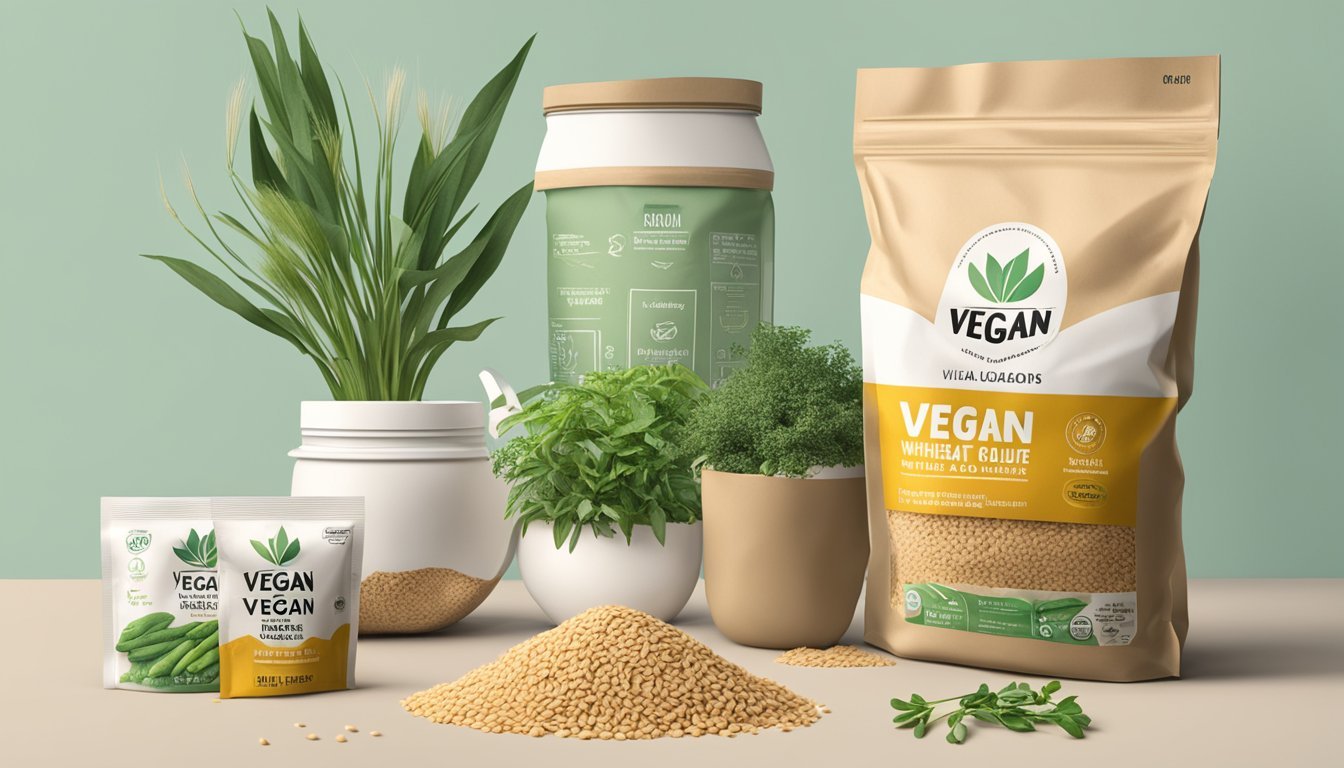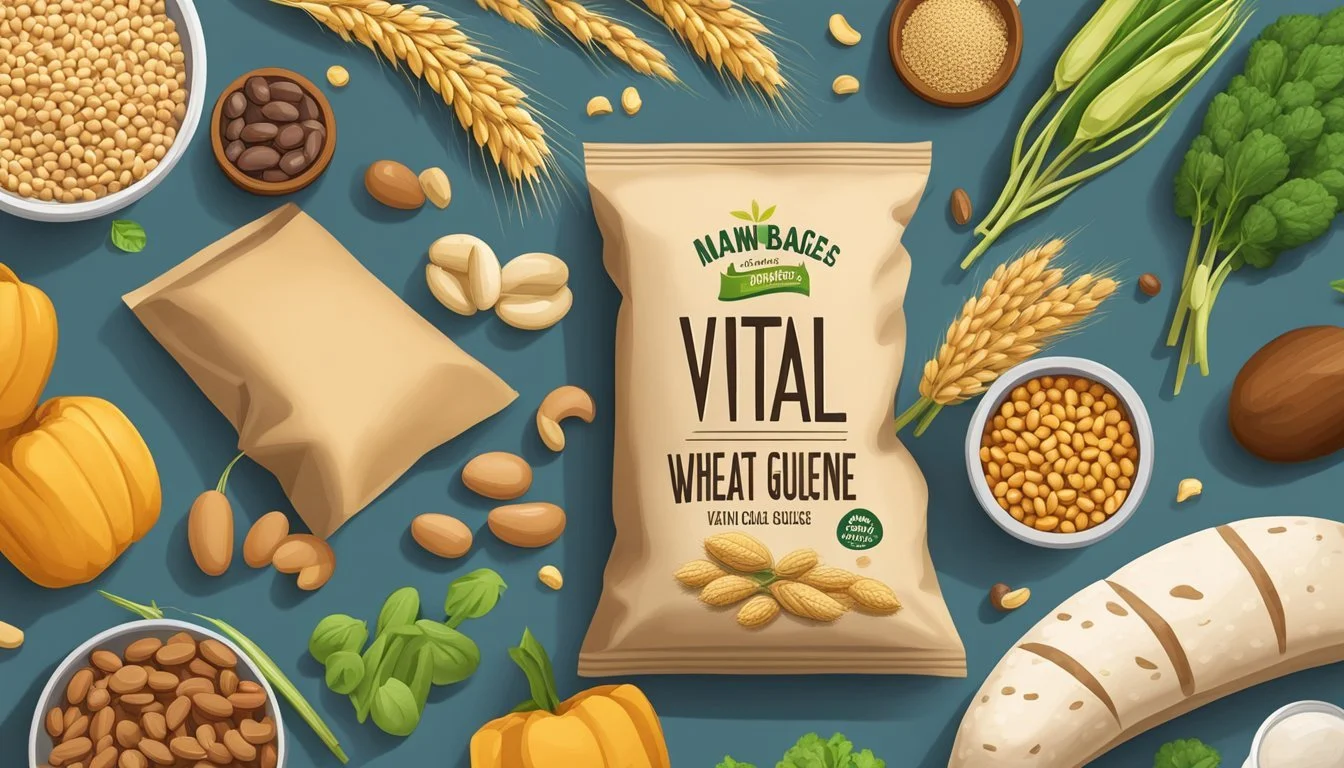Is Vital Wheat Gluten Vegan?
Understanding its Plant-Based Origins
Vital wheat gluten is a protein-rich flour commonly used as a staple in many vegan diets. It is derived from wheat and essentially consists of the gluten that's left after the starch has been removed from wheat flour. This powerful ingredient holds a significant place in vegan cooking because it mimics the texture and protein content of meat, making it a popular base for meat substitutes such as seitan. (What wine goes well with seitan?) It serves as an indispensable component for those seeking to prepare high-protein, plant-based meals.
Its origins from wheat make vital wheat gluten inherently vegan, as it does not contain any animal products or by-products. As a purely plant-derived substance, it fits comfortably within the parameters of vegan dietary choices. Its versatility also shines in the culinary world, where it's used to craft an array of creative dishes, ranging from vegan sausages to meat-free deli slices, providing both substance and texture that can be hard to achieve with other vegan protein sources.
Moreover, the protein content of vital wheat gluten far exceeds that of regular flour, making it an excellent source of protein for those on a vegan diet. While typical all-purpose flour has a protein content of about 9-11%, and bread flour contains around 11-13%, vital wheat gluten boasts a protein concentration of about 70%. This concentration allows it to serve as a robust building block for many plant-based recipes, supporting the nutritional needs of vegans while enabling a wide scope for culinary exploration and innovation.
Vital Wheat Gluten 101
Vital wheat gluten packs a high-protein punch and serves as an essential ingredient for those subscribing to a vegan diet. It is derived from wheat flour, emphasizing the gluten component, which is crucial for various culinary applications.
Nature of Vital Wheat Gluten
Vital wheat gluten is essentially the protein component of wheat flour, consisting predominantly of gluten. It exhibits a unique viscoelastic property, which renders it an indispensable ingredient for both baking and meat substitutes. In baking, its elasticity enhances dough stretchability, contributing significantly to the bread's final texture. For vegan meat alternatives, such as seitan, its ability to mimic a meaty texture makes it a favorite.
Ingredient Profile:
Content: Concentrated protein (~75-80% protein)
Composition: Mostly gluten, the protein found in wheat
Characteristics: Elastic, chewy, and versatile
Sourcing and Processing
Vital wheat gluten is a derivative of wheat flour, conventionally sourced from the endosperm of wheat grains. The process begins with hydrating wheat flour to activate the gluten. Subsequently, the gluten is separated from the starch through a washing process that leaves behind a glutinous mass. This mass is then dried and ground into a fine powder known as vital wheat gluten or gluten flour.
Simplified Process:
Step Description Hydration Wheat flour is mixed with water to form a dough. Gluten Activation Kneading the dough helps to develop the gluten by linking glutenin and gliadin proteins. Separation The dough is rinsed to wash away starches, leaving behind the gluten protein. Drying and Milling The remaining gluten is dried and ground to produce the powdery substance known as vital wheat gluten.
This powder can be easily stored and later rehydrated to serve various purposes in cooking and baking, proving particularly beneficial in constructing vegan and vegetarian dishes (What wine goes well with vegetarian dishes?) that require a meat-like consistency.
Veganism and Food Sources
In the context of veganism, understanding diverse food sources, particularly those rich in protein, is critical for maintaining a balanced and nutritious vegan diet.
Defining Veganism
Veganism is a dietary and lifestyle choice that excludes all forms of animal products. Vegans avoid consuming meat, dairy, eggs, and other substances derived directly or indirectly from animals. The primary motivation for people who adopt veganism ranges from ethical concerns regarding animal welfare to environmental factors and health considerations.
Vegan Dietary Sources of Protein
Protein is a crucial macronutrient for everyone, including vegans, as it is essential for building and repairing tissues and supporting overall bodily functions. Vegans must source protein from plant-based alternatives to meet their dietary requirements. Here is a list of common vegan protein sources:
Legumes: Beans, lentils, chickpeas, and peas are rich in protein and other nutrients.
Soy Products: Tofu, tempeh, and edamame are made from soybeans and serve as versatile protein-rich foods. Soy sauce, while not a significant protein source, is commonly used in vegan cooking.
Grains: Quinoa and buckwheat are complete sources of protein, containing all nine essential amino acids.
Nuts and Seeds: Almonds, chia seeds, flaxseeds, and hemp seeds are not only packed with protein but also contain healthy fats and fiber.
Meat Substitutes: Vegan meat alternatives like seitan (made from vital wheat gluten), meatless burgers, and sausages are designed to replicate the texture and taste of meat using vegan ingredients.
It's noteworthy that seitan, a popular vegan meat substitute, is made from vital wheat gluten and is nearly pure protein, with a content of about 75-80% protein by weight. As a result, it is frequently used in vegan diets as a meat alternative for its high protein and versatility in various recipes. However, it is important to note that seitan and other wheat-based protein sources are unsuitable for individuals with gluten sensitivities or celiac disease.
Analyzing Seitan
Seitan, also known as vital wheat gluten, has become a staple in vegan diets as a protein-rich meat alternative. Its versatility in recipes and considerable nutritional value presents it as a favorable option among plant-based proteins.
Seitan as a Vegan Option
Seitan is made from gluten, the main protein in wheat. As it is entirely plant-based, seitan serves as a popular choice for vegans looking for a meat substitute. With a meaty texture, it can mimic various types of meat, such as vegan chicken, vegan meatballs, and more. Seitan is often used in an array of dishes including stir-fry, stews, burgers, and sandwiches, appealing to those who desire the texture and flavor of meat without consuming animal products.
Nutritional Profile of Seitan
In terms of nutrition, seitan is a powerhouse of protein with about 15 to 21 grams of protein per 3-ounce serving. Here's a brief nutritional overview per serving:
Calories: 70-100
Fat: 0.5 grams (minimal saturated fat)
Carbohydrates: 3-8 grams (little to no sugar)
Iron: 8% of the Daily Value (DV)
Potassium: 2-3% of DV
Calcium: 4% of DV
While seitan is low in fats and sugars, it lacks certain amino acids, making it important to consume a varied diet to obtain all essential nutrients.
Culinary Uses of Seitan
Seitan can be easily made at home or purchased ready-made. Homemade seitan recipes typically involve combining vital wheat gluten with water and a blend of spices, then it is cooked to achieve the desired consistency. The texture of seitan is similar to that of meat, which enables it to soak up flavors well, making it a highly versatile ingredient. It's especially popular in recipes where a chewy or dense texture is preferred and can be grilled, baked, sautéed, or even used as a filling for sandwiches and wraps.
Preparation Techniques
Preparing vital wheat gluten to create a savory vegan product relies on specific techniques and flavor enhancements. These methods ensure seitan has a desirable texture and satisfies diverse culinary preferences.
Creating Homemade Seitan
To create homemade seitan, or "wheat meat," the cook begins with the essential ingredient: vital wheat gluten. It's combined with water — in a typical ratio of roughly one cup of vital wheat gluten to three-quarters cup of water — to form a dense dough. The steps for making seitan typically involve:
Mixing the vital wheat gluten with water until a dough is formed.
Kneading the dough to develop the gluten strands, which will provide the chewy, meat-like texture.
Shaping the dough into a loaf or cutlets, depending on the desired end product.
Cooking methods include boiling, steaming, or baking. For instance, a dough can be cut into pieces and simmered in a flavored broth, wrapped tightly in foil and baked, or shaped and steamed to retain moisture.
Seasoning and Flavoring Seitan
Flavor is infused into seitan through a variety of seasonings and techniques. The base dough of gluten and water is a blank canvas that takes on flavors well, so cooks incorporate a blend of spices, herbs, soy sauce, and nutritional yeast to achieve a rich umami and depth of taste. Common additions include:
Garlic powder and onion powder add a foundational savoriness.
Soy sauce or tamari provides salty depth and is often used in the cooking liquid or dough.
Fresh or dried herbs contribute accents of flavor tailored to the recipe's theme.
Salt is essential for taste and can be adjusted according to dietary needs.
Unique flavors can be achieved by introducing smoked paprika for a hint of smokiness, olive oil for richness, or a touch of sweetness with natural sweeteners. It is crucial to balance these elements to build a complex flavor profile without overpowering the seitan.
Storing and Preservation
The vegan protein staple, seitan, which is made from vital wheat gluten, requires certain storage techniques to maintain its quality and extend shelf life. Specific methods such as freezing and understanding the product's shelf life are critical for long-term preservation.
Freezing and Thawing Seitan
Freezing is an ideal method for extending the life of seitan. For effective freezing, one should:
Prep: Cook seitan thoroughly before freezing.
Storage: Wrap the seitan in plastic wrap and then place it into an airtight container or freezer bag.
Freeze: Ensure the freezer is at 0°F (-18°C) for optimal preservation.
Thawing: To thaw, one should transfer the seitan to the refrigerator 24 hours before it is needed or thaw it in a microwave if they are short on time.
Reuse: Seitan can be frozen for up to three months without compromising its quality.
Shelf Life Considerations
When storing seitan in the pantry or refrigerator, the following should be kept in mind:
Pantry: Seitan, in the form of vital wheat gluten powder, should be kept in a cool, dry place to avoid degradation, ideally below 60°F (15°C). The pantry can be a suitable place away from light and moisture.
Refrigeration: Cooked seitan can be refrigerated to extend its freshness. It should be consumed within 5-7 days when stored in the refrigerator.
Containers: Use airtight containers to protect seitan from moisture and other contaminants.
Meal Prep: When used for meal prep, portion seitan into meal-size servings to avoid thawing more than necessary.
Cooking With Seitan
Seitan, a versatile vegan meat alternative, can be adeptly used in a myriad of dishes, capitalizing on its meat-like texture and ability to absorb flavors. Explore how seitan can transform traditional meat-based recipes into plant-based delights and uncover a variety of methods to cook seitan that range from barbecuing to stir-frying.
Incorporating Seitan in Dishes
In the realm of vegan cuisine, seitan stands out as a substantial substitute for meat. Its dense, chewy texture makes it an excellent addition to stir-fries and burgers, where it seamlessly integrates with vegetables and sauces. One can craft flavorful gyros or enhance a salad with strips of seasoned seitan for added protein. The key to a successful seitan dish is the recipe and seasoning; whether it's marinating it for a BBQ or infusing spices for steaks, seitan absorbs flavors well, allowing for a range of culinary creativity.
Burgers: Form seitan into patties and grill for a hearty vegan burger.
Stir-Fries: Sauté cubed seitan with a mix of veggies and a savory sauce.
Gyros: Thinly slice seitan and serve in pita bread with tzatziki and fresh tomatoes.
Salads: Use chilled, julienne-cut seitan as a protein-rich topping for salads.
Alternative Cooking Methods
Seitan's adaptability extends to its preparation methods. Beyond the common pan-frying, seitan can take center stage at a grill for a smoke-infused flavor, mirroring traditional BBQ meats. When it comes to replicating hot dogs or sandwiches, steaming seitan can help maintain moisture and tenderness. Baking seitan brings out a firmer texture, making it suitable for recipes requiring sturdier components like steaks. Explore these diverse techniques to find the perfect fit for each savory dish.
Grilling: Perfect for achieving a smoky and charred exterior.
Steaming: Maintains seitan's moisture for juicy bites.
Baking: Yields a firmer texture ideal for slicing into steaks.
Potential Dietary Restrictions
When considering vital wheat gluten in a diet, individuals must take into account dietary restrictions associated with gluten sensitivity and compare seitan with other vegan meat alternatives for a more inclusive approach.
Seitan and Gluten Sensitivity
Seitan, a meat substitute made from vital wheat gluten, is not suitable for individuals with celiac disease or non-celiac gluten sensitivity. Since seitan comprises mostly gluten, the main protein found in wheat, it can trigger adverse reactions for those who are intolerant to this protein. For those requiring a gluten-free diet, it's crucial to avoid seitan and explore other options for protein intake.
Comparing Seitan with Other Meat Alternatives
When comparing seitan to other vegan meat alternatives, one should consider not only the presence of gluten but also other dietary needs, such as soy-free or nut-free diets. The table below outlines different vegan meat alternatives along with their composition, which can help individuals choose the suitable option for their dietary restrictions:
Meat Alternative Primary Ingredient Gluten-Free Soy-Free Tempeh Fermented soybeans Yes No Beans Various legumes Yes Yes Chickpea Flour Ground chickpeas Yes Yes Jackfruit Tropical fruit Yes Yes
While seitan is rich in protein and mimics the texture of meat well, it is not a viable option for those avoiding gluten. Beans, chickpea flour, and jackfruit offer gluten-free and often soy-free alternatives. They provide diverse textures and flavors but may not always match the chewiness or protein content provided by seitan. Depending on the dietary restriction, individuals should weigh the pros and cons of each alternative to find the most suitable meat substitute for their vegan diet.
Consumer Resources
Consumers looking to incorporate vital wheat gluten into their diets have multiple resources at their disposal. These resources range from grocery store selections to digital platforms for DIY assistance.
Finding Seitan Products
Grocery stores often carry seitan, which is a popular vegan substitute made from vital wheat gluten. It comes in various forms such as strips, chunks, or ground. When searching for these products, shoppers should look in the refrigerated section alongside tofu and other meat alternatives.
Local Health Food Stores: Typically have a variety of seitan products.
Whole Foods Market: Known for carrying multiple brands of ready-to-use seitan.
Conventional Grocery Stores: Increasingly stock seitan products due to growing demand.
Shoppers may also check online retailers such as Amazon for a wide selection of seitan products. They can read reviews to ensure the quality and suitability of the seitan to their taste preferences and dietary needs.
DIY Seitan and Online Resources
For those interested in creating their own seitan, several online resources provide easy-to-follow vegan recipes. A basic seitan recipe usually involves mixing vital wheat gluten with a liquid like vegetable broth and spices, then cooking it.
Equipment Needed: Bowl, measuring tools, food processor (optional for mixing), and cooking pot.
Ingredients: Vital wheat gluten, vegetable broth for flavor, and spices or herbs for seasoning.
Instagram and food blogs are great places for inspiration and step-by-step guides on making seitan from scratch. Here, one can find seitan recipes ranging from basic to gourmet, shared by vegan cooks and chefs:
Instagram: Search for hashtags like #seitan or #veganrecipes.
Vegan Food Blogs: Offer diverse recipes and tips for making seitan.
Online forums and websites often feature user-generated content where individuals share their homemade seitan experiences, providing valuable tips and tricks to improve texture and flavor. Consumers can utilize these platforms to enhance their homemade seitan dishes.








